Abstract
Recent studies on the initial stages in oxidation of low density lipoprotein (LDL) have revealed certain previously unrecognized similarities to emulsion polymerization and some quite unexpected features including the following: (i) ascorbate is an extremely effective antioxidant for LDL containing alpha-tocopherol (alpha-TOH); (ii) in the presence of alpha-TOH and in the absence of both ascorbate and ubiquinol 10 (Q10H2), oxidation of LDL occurs via a free radical chain; (iii) Q10H2 is a much better antioxidant for LDL than alpha-TOH, although the reverse is true in homogeneous systems. We show here that these problems can be solved on the basis of three simple hypothesis, each of which is based on known chemistry: (i) alpha-TOH in LDL can be regenerated from its radical, alpha-TO., by ascorbate; (ii) in the absence of ascorbate and Q10H2, the alpha-TOH in LDL acts as a chain-transfer agent rather than as a radical trap; (iii) Q10H2 is a much more effective chain-breaking antioxidant than alpha-TOH in LDL because the semiquinone radical Q10H. exports its radical character from the LDL into the aqueous phase. Our conclusions imply that the search for better antiatherosclerotic drugs might profitably focus on antioxidants capable of exporting radicals from LDL particles or otherwise increasing the traffic of radicals between particles.
Full text
PDF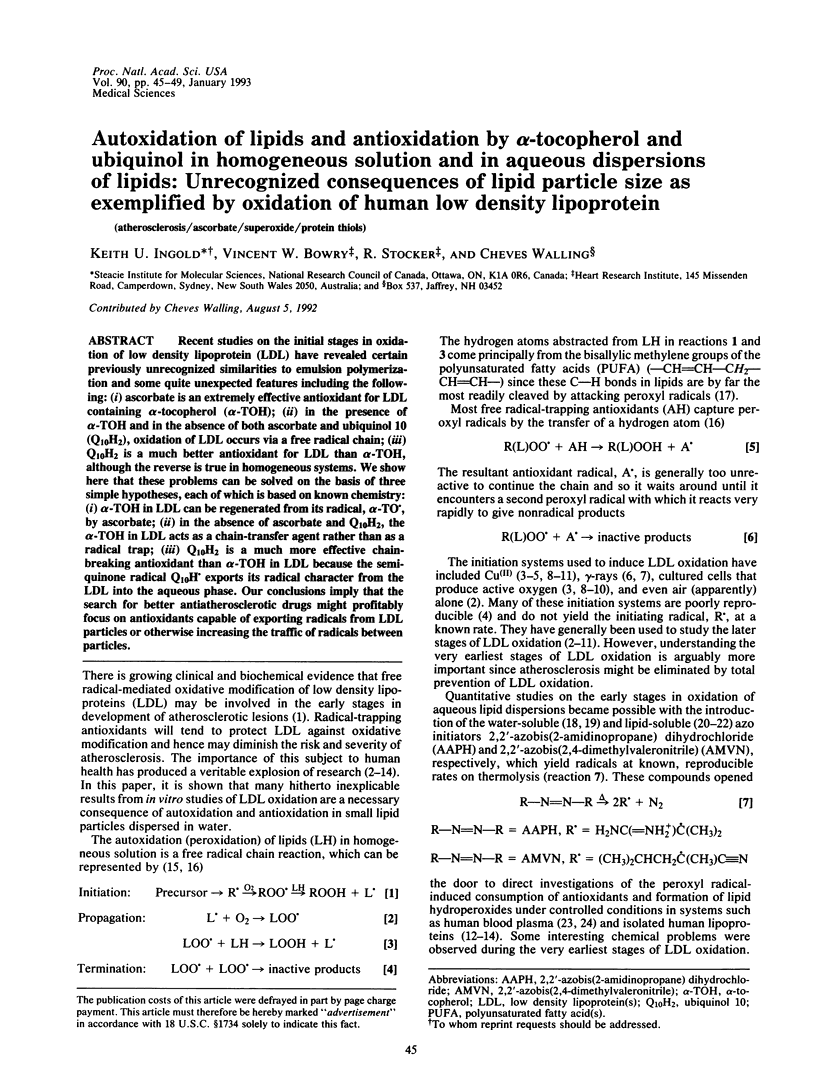
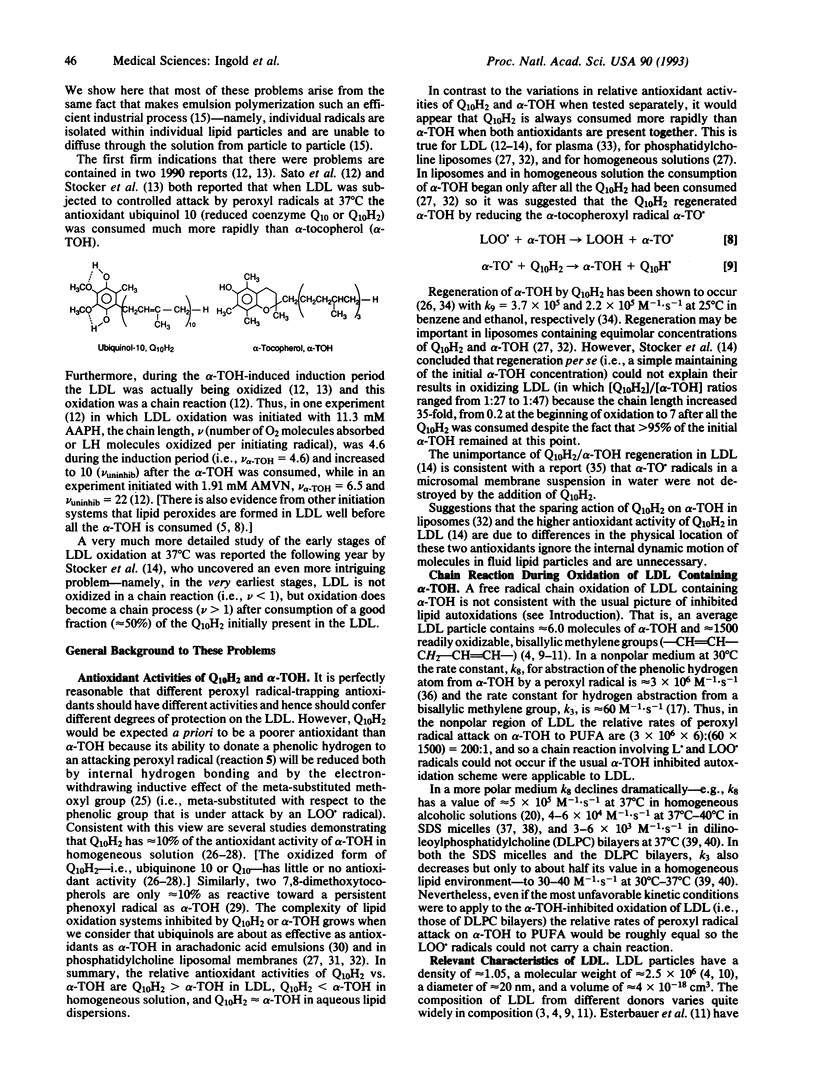
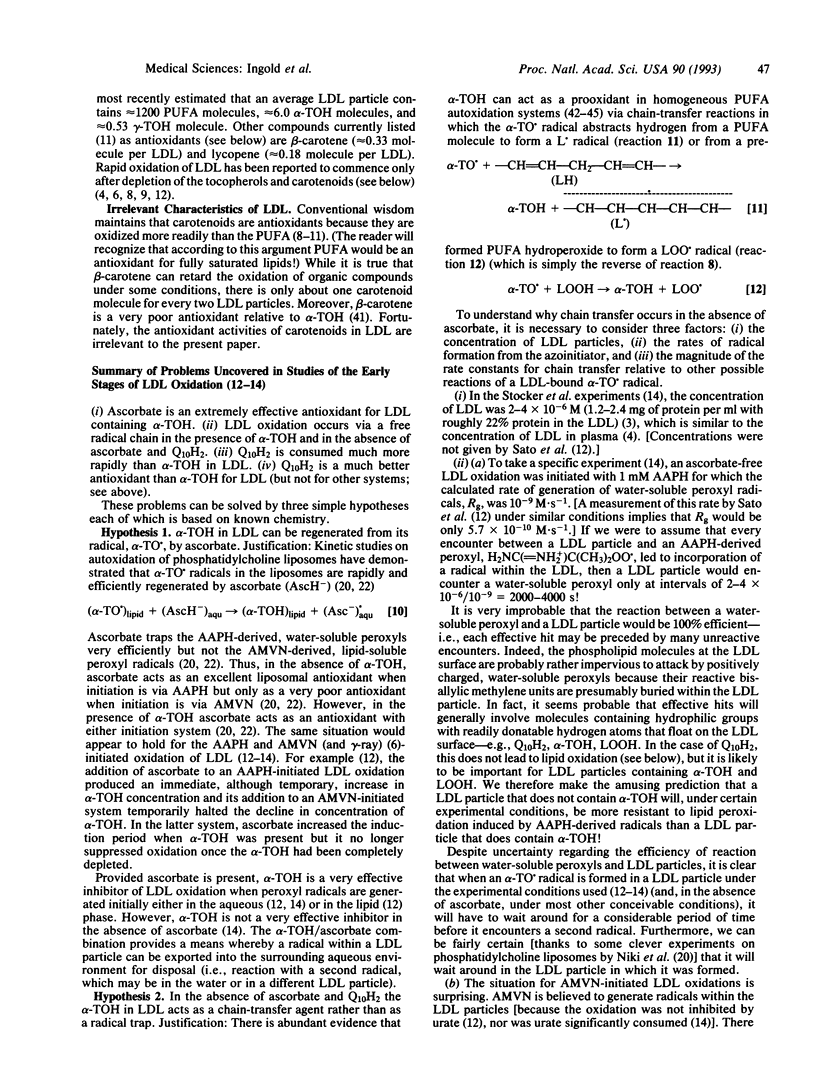
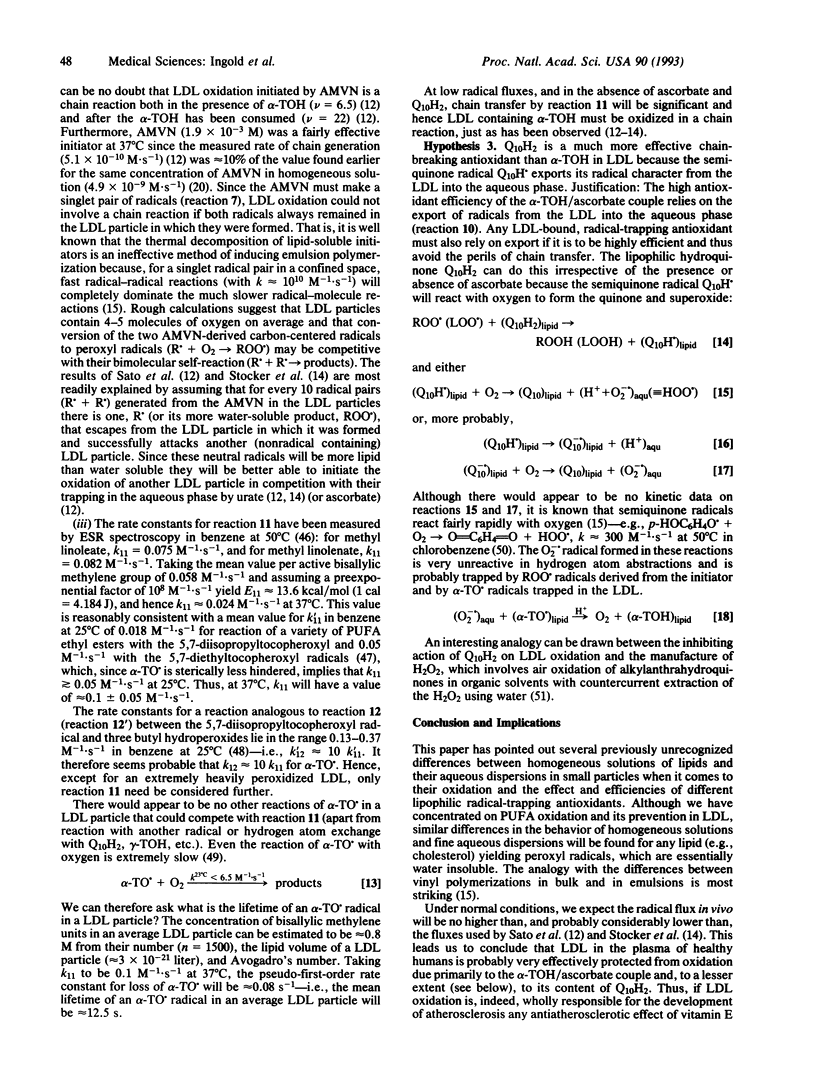
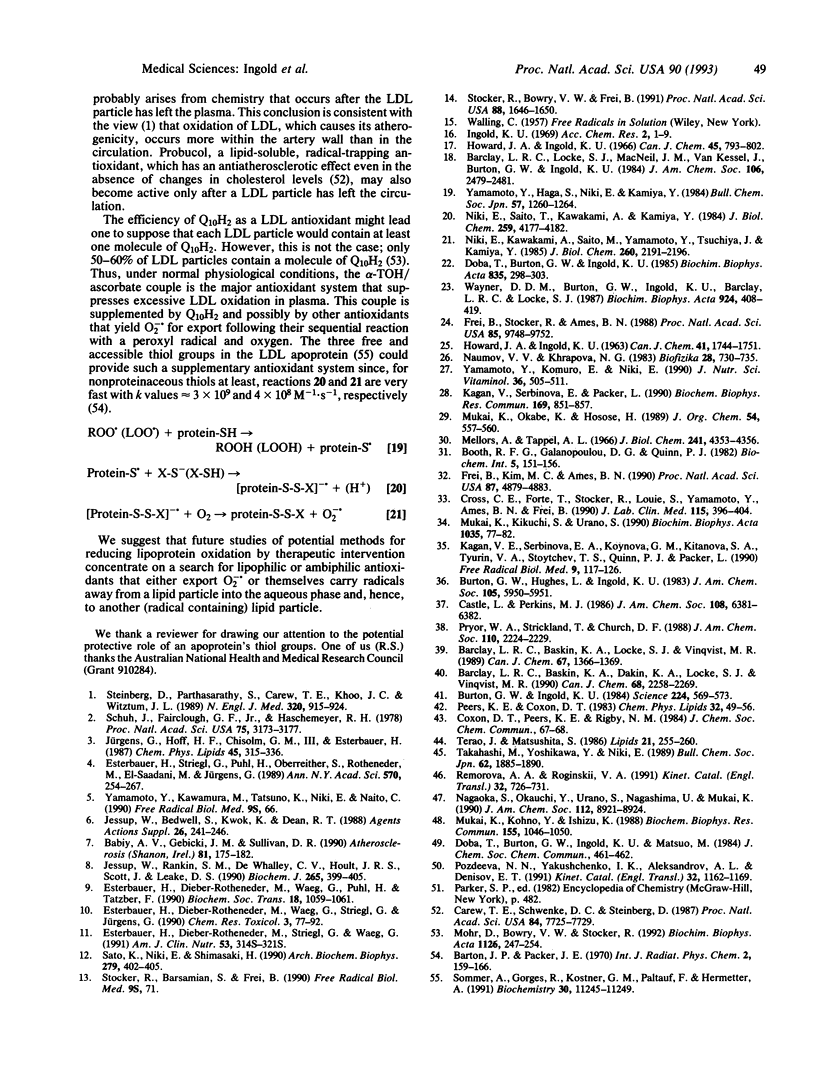
Selected References
These references are in PubMed. This may not be the complete list of references from this article.
- Babiy A. V., Gebicki J. M., Sullivan D. R. Vitamin E content and low density lipoprotein oxidizability induced by free radicals. Atherosclerosis. 1990 Apr;81(3):175–182. doi: 10.1016/0021-9150(90)90064-p. [DOI] [PubMed] [Google Scholar]
- Burton G. W., Ingold K. U. beta-Carotene: an unusual type of lipid antioxidant. Science. 1984 May 11;224(4649):569–573. doi: 10.1126/science.6710156. [DOI] [PubMed] [Google Scholar]
- Carew T. E., Schwenke D. C., Steinberg D. Antiatherogenic effect of probucol unrelated to its hypocholesterolemic effect: evidence that antioxidants in vivo can selectively inhibit low density lipoprotein degradation in macrophage-rich fatty streaks and slow the progression of atherosclerosis in the Watanabe heritable hyperlipidemic rabbit. Proc Natl Acad Sci U S A. 1987 Nov;84(21):7725–7729. doi: 10.1073/pnas.84.21.7725. [DOI] [PMC free article] [PubMed] [Google Scholar]
- Cross C. E., Forte T., Stocker R., Louie S., Yamamoto Y., Ames B. N., Frei B. Oxidative stress and abnormal cholesterol metabolism in patients with adult respiratory distress syndrome. J Lab Clin Med. 1990 Apr;115(4):396–404. [PubMed] [Google Scholar]
- Doba T., Burton G. W., Ingold K. U. Antioxidant and co-antioxidant activity of vitamin C. The effect of vitamin C, either alone or in the presence of vitamin E or a water-soluble vitamin E analogue, upon the peroxidation of aqueous multilamellar phospholipid liposomes. Biochim Biophys Acta. 1985 Jul 9;835(2):298–303. doi: 10.1016/0005-2760(85)90285-1. [DOI] [PubMed] [Google Scholar]
- Esterbauer H., Dieber-Rotheneder M., Striegl G., Waeg G. Role of vitamin E in preventing the oxidation of low-density lipoprotein. Am J Clin Nutr. 1991 Jan;53(1 Suppl):314S–321S. doi: 10.1093/ajcn/53.1.314S. [DOI] [PubMed] [Google Scholar]
- Esterbauer H., Dieber-Rotheneder M., Waeg G., Puhl H., Tatzber F. Endogenous antioxidants and lipoprotein oxidation. Biochem Soc Trans. 1990 Dec;18(6):1059–1061. doi: 10.1042/bst0181059. [DOI] [PubMed] [Google Scholar]
- Esterbauer H., Dieber-Rotheneder M., Waeg G., Striegl G., Jürgens G. Biochemical, structural, and functional properties of oxidized low-density lipoprotein. Chem Res Toxicol. 1990 Mar-Apr;3(2):77–92. doi: 10.1021/tx00014a001. [DOI] [PubMed] [Google Scholar]
- Esterbauer H., Striegl G., Puhl H., Oberreither S., Rotheneder M., el-Saadani M., Jürgens G. The role of vitamin E and carotenoids in preventing oxidation of low density lipoproteins. Ann N Y Acad Sci. 1989;570:254–267. doi: 10.1111/j.1749-6632.1989.tb14925.x. [DOI] [PubMed] [Google Scholar]
- Frei B., Kim M. C., Ames B. N. Ubiquinol-10 is an effective lipid-soluble antioxidant at physiological concentrations. Proc Natl Acad Sci U S A. 1990 Jun;87(12):4879–4883. doi: 10.1073/pnas.87.12.4879. [DOI] [PMC free article] [PubMed] [Google Scholar]
- Frei B., Stocker R., Ames B. N. Antioxidant defenses and lipid peroxidation in human blood plasma. Proc Natl Acad Sci U S A. 1988 Dec;85(24):9748–9752. doi: 10.1073/pnas.85.24.9748. [DOI] [PMC free article] [PubMed] [Google Scholar]
- Jessup W., Bedwell S., Kwok K., Dean R. T. Oxidative modification of low-density lipoprotein: initiation by free radicals and protection by antioxidants. Agents Actions Suppl. 1988;26:241–246. [PubMed] [Google Scholar]
- Jessup W., Rankin S. M., De Whalley C. V., Hoult J. R., Scott J., Leake D. S. Alpha-tocopherol consumption during low-density-lipoprotein oxidation. Biochem J. 1990 Jan 15;265(2):399–405. doi: 10.1042/bj2650399. [DOI] [PMC free article] [PubMed] [Google Scholar]
- Jürgens G., Hoff H. F., Chisolm G. M., 3rd, Esterbauer H. Modification of human serum low density lipoprotein by oxidation--characterization and pathophysiological implications. Chem Phys Lipids. 1987 Nov-Dec;45(2-4):315–336. doi: 10.1016/0009-3084(87)90070-3. [DOI] [PubMed] [Google Scholar]
- Kagan V. E., Serbinova E. A., Koynova G. M., Kitanova S. A., Tyurin V. A., Stoytchev T. S., Quinn P. J., Packer L. Antioxidant action of ubiquinol homologues with different isoprenoid chain length in biomembranes. Free Radic Biol Med. 1990;9(2):117–126. doi: 10.1016/0891-5849(90)90114-x. [DOI] [PubMed] [Google Scholar]
- Kagan V., Serbinova E., Packer L. Antioxidant effects of ubiquinones in microsomes and mitochondria are mediated by tocopherol recycling. Biochem Biophys Res Commun. 1990 Jun 29;169(3):851–857. doi: 10.1016/0006-291x(90)91971-t. [DOI] [PubMed] [Google Scholar]
- Mellors A., Tappel A. L. The inhibition of mitochondrial peroxidation by ubiquinone and ubiquinol. J Biol Chem. 1966 Oct 10;241(19):4353–4356. [PubMed] [Google Scholar]
- Mohr D., Bowry V. W., Stocker R. Dietary supplementation with coenzyme Q10 results in increased levels of ubiquinol-10 within circulating lipoproteins and increased resistance of human low-density lipoprotein to the initiation of lipid peroxidation. Biochim Biophys Acta. 1992 Jun 26;1126(3):247–254. doi: 10.1016/0005-2760(92)90237-p. [DOI] [PubMed] [Google Scholar]
- Mukai K., Kikuchi S., Urano S. Stopped-flow kinetic study of the regeneration reaction of tocopheroxyl radical by reduced ubiquinone-10 in solution. Biochim Biophys Acta. 1990 Jul 20;1035(1):77–82. doi: 10.1016/0304-4165(90)90176-w. [DOI] [PubMed] [Google Scholar]
- Mukai K., Kohno Y., Ishizu K. Kinetic study of the reaction between vitamin E radical and alkyl hydroperoxides in solution. Biochem Biophys Res Commun. 1988 Sep 15;155(2):1046–1050. doi: 10.1016/s0006-291x(88)80602-8. [DOI] [PubMed] [Google Scholar]
- Niki E., Kawakami A., Saito M., Yamamoto Y., Tsuchiya J., Kamiya Y. Effect of phytyl side chain of vitamin E on its antioxidant activity. J Biol Chem. 1985 Feb 25;260(4):2191–2196. [PubMed] [Google Scholar]
- Niki E., Saito T., Kawakami A., Kamiya Y. Inhibition of oxidation of methyl linoleate in solution by vitamin E and vitamin C. J Biol Chem. 1984 Apr 10;259(7):4177–4182. [PubMed] [Google Scholar]
- Sato K., Niki E., Shimasaki H. Free radical-mediated chain oxidation of low density lipoprotein and its synergistic inhibition by vitamin E and vitamin C. Arch Biochem Biophys. 1990 Jun;279(2):402–405. doi: 10.1016/0003-9861(90)90508-v. [DOI] [PubMed] [Google Scholar]
- Schuh J., Fairclough G. F., Jr, Haschemeyer R. H. Oxygen-mediated heterogeneity of apo-low-density lipoprotein. Proc Natl Acad Sci U S A. 1978 Jul;75(7):3173–3177. doi: 10.1073/pnas.75.7.3173. [DOI] [PMC free article] [PubMed] [Google Scholar]
- Sommer A., Gorges R., Kostner G. M., Paltauf F., Hermetter A. Sulfhydryl-selective fluorescence labeling of lipoprotein(a) reveals evidence for one single disulfide linkage between apoproteins(a) and B-100. Biochemistry. 1991 Nov 26;30(47):11245–11249. doi: 10.1021/bi00111a008. [DOI] [PubMed] [Google Scholar]
- Steinberg D., Parthasarathy S., Carew T. E., Khoo J. C., Witztum J. L. Beyond cholesterol. Modifications of low-density lipoprotein that increase its atherogenicity. N Engl J Med. 1989 Apr 6;320(14):915–924. doi: 10.1056/NEJM198904063201407. [DOI] [PubMed] [Google Scholar]
- Stocker R., Bowry V. W., Frei B. Ubiquinol-10 protects human low density lipoprotein more efficiently against lipid peroxidation than does alpha-tocopherol. Proc Natl Acad Sci U S A. 1991 Mar 1;88(5):1646–1650. doi: 10.1073/pnas.88.5.1646. [DOI] [PMC free article] [PubMed] [Google Scholar]
- Wayner D. D., Burton G. W., Ingold K. U., Barclay L. R., Locke S. J. The relative contributions of vitamin E, urate, ascorbate and proteins to the total peroxyl radical-trapping antioxidant activity of human blood plasma. Biochim Biophys Acta. 1987 Jun 22;924(3):408–419. doi: 10.1016/0304-4165(87)90155-3. [DOI] [PubMed] [Google Scholar]
- Yamamoto Y., Komuro E., Niki E. Antioxidant activity of ubiquinol in solution and phosphatidylcholine liposome. J Nutr Sci Vitaminol (Tokyo) 1990 Oct;36(5):505–511. doi: 10.3177/jnsv.36.505. [DOI] [PubMed] [Google Scholar]


